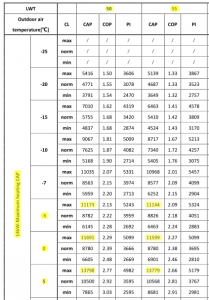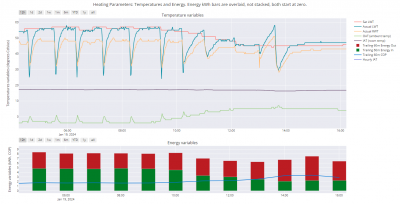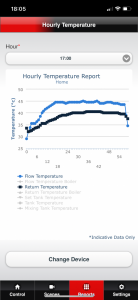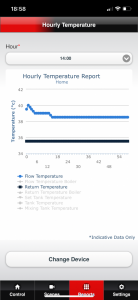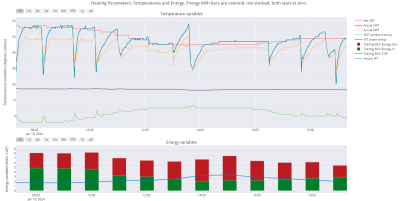Posted by: @iancalderbankIf you stand by the heat pump its a LOT colder when its running.
This is one of the points I made earlier, cooling the local air is as far as I can see normal behaviour for a heat pump, and to that extent many if not most heat pumps operate in what @derek-m calls a cold well, and other call a microclimate. It makes total sense, you take air in, extract heat from it, and push it out, it is going to colder than the air going in. The point being that the aberrant behaviour seen by some in my heat pump may not be aberrant, it may be normal, but we don't know that because so few people post detailed enough data.
Both of our charts show a rise in OAT as measured locally during the defrosts, or, if looked at the other way, a cooling of the OAT when the heat pump is running normally. The pattern, give o take minor details, is the same.
I can try lowering the left hand end of the WCC today, while it is still cold outside, and see what happens...
11:40: OK, left hand end of WCC baseline set LWT (what it runs at without auto-adaption changing it) lowered from 56 to 50 degrees. The auto adapt script runs every hour at 30 mins past the hour, so won't actually change anything until 12:30.
Midea 14kW (for now...) ASHP heating both building and DHW
@derek-m - I do wonder if it is time to drop the cold well seriously compromises my heat pump hypothesis, on the grounds that it seems increasingly likely that many if not most heat pumps operate in similar circumstances to mine, and experience the cycling spikes in OAT when it is measured in or near the heat pump, we just don't know that is the case because most people don't record and post minute by minute data. In other words, my heat pump setting isn't exceptional, and either the cold well effect is not that important, or if it is, then it will affect many of not most heat pumps. In other words, it isn't the exception that explains my heat pump behaviour, as being seriously compromised compared to other installations.
Midea 14kW (for now...) ASHP heating both building and DHW
House-2 bed partial stone bungalow, 5kW Samsung Gen 6 ASHP (Self install)
6.9 kWp of PV
5kWh DC coupled battery
Blog: https://thegreeningofrosecottage.weebly.com/
Heatpump Stats: http://heatpumpmonitor.org/system/view?id=60
@cathoderay unless you've got an install that doesn't comply with the MI's in terms of airflow clearances (check the installer guide) , in your position I'd focus my attention on:
- can I run at a lower LWT? If in doubt, just try it whilst its cold! what happens to the indoor temps?
- check the mfr data book. does capacity increase if I lower LWT? COP will for certain.
- do I have the same flow rates and temperatures either side of my PHEX (which feeds to point 1) ?
My octopus signup link https://share.octopus.energy/ebony-deer-230
210m2 house, Samsung 16kw Gen6 ASHP Self installed: Single circulation loop , PWM modulating pump.
My public ASHP stats: https://heatpumpmonitor.org/system/view?id=45
11.9kWp of PV
41kWh of Battery storage (3x Powerwall 2)
2x BEVs
Posted by: @cathoderay@iancalderbank - your second chart, zooming in on a single defrost cycle, is interesting, in that, apart from the RWT, and a slightly different but not by much time frame, the temps follow exactly the same pattern as seen in my zoom in on a single defrost chart. Interesting, in that two different installations with different brands of heat pumps do the same thing.
I wonder, does your heat pump sit in it's own microclimate? You have the same rise in OAT during the defrost as I do, which according to @derek-m's theory means that at other times the normally running heat pump is lowering the OAT. My own view, as you will know, is that this is normal behaviour that applies to many if not most heat pumps.
The failure of my system to reach the desired/design IAT in cold weather is I think largely another problem: the heat pump is simply under-specced for the loss/demand. Of course other factors affecting efficiency don't help, but the root cause is 11kW supplied will never meet a 12kW loss.
I think that a defrost is likely to cause an increase in reading from the OAT sensor, because not only is hot refrigerant gas being pushed through the evaporator in close proximity to the sensor, but I do believe the fan is slowed down or even stopped during the process. During normal operation the fan would be pulling air past the OAT sendor, then through the evaporator, before exhausting the air out of the front grill. The OAT sensor should therefore be responding to the air coming into the heat pump, before thermal energy has been extracted, and the air cooled.
If you look at the raw data for 7th November 2023, when the setback commenced at 21:00 the OAT sensor reading was 5C, but by 21:20 the reading had increased to 9C, which again I don't think is the normal rate of change of ambient air temperature.
If I am correct then you may be able to do something to alleviate the problem, if I am wrong then a suitable resolution may be more difficult to achieve.
The other thing that it may be prudent to check, is the capability of the PHE to actually transfer the required quantity of thermal energy to the heat emitters.
Posted by: @bontwoodyHave you come across this Heat Geek video?
Looks interesting, thanks for posting, will watch it when I have a chance.
Posted by: @iancalderbankunless you've got an install that doesn't comply with the MI's in terms of airflow clearances (check the installer guide) , in your position I'd focus my attention on:
- can I run at a lower LWT? If in doubt, just try it whilst its cold! what happens to the indoor temps?
- check the mfr data book. does capacity increase if I lower LWT? COP will for certain.
- do I have the same flow rates and temperatures either side of my PHEX (which feeds to point 1) ?
The installation meets (exceeds) the airflow requirements in the installation guide. Here are both Midea and Freedom's requirements:
I've already lowered the left hand WCC Set LWT from 56 to 50 degrees (see previous post).
The Midea output tables aren't the easiest to use, for example they have three 'capacity levels', min, norm and max, and the output varies a lot depending on which it is, but I have not found a way of knowing what level my pump is currently running at. That said, lowering the LWT from 55 to 50 degrees has very little impact on quoted output eg (I've highlighted the 'max' values at the sort of OATs I have at the moment):
There is a drop in temp over the PHE, most of the time, of a few degrees. It is difficult to measure as it changes all the time, and the measuring instrument, an IR thermometer aimed at black insulating tape on pipework, is far from perfect. Although I do know the primary flow rate, both from the wired controller and a crude analogue in line meter (and temps at the heat pump end of the circuit) I have no way of measuring the flow rate on the secondary circuit, without adding expensive and invasive monitoring equipment. I will see if it can be guessed at from the manufacturer's data and the current settings.
Midea 14kW (for now...) ASHP heating both building and DHW
@cathoderay do you have the whole table? or a link to it. max is probably the one that matters given you are trying to run it flat out right now. disappointing that its nominally a 14 but only 11.something in cold weather. COP clearly better the cooler you run.
its really worth trying to quantify how much you are losing across the PHEX. I saw a post on here the other day they had bought cheap sensors with simple digital displays on them, from amazon, to troubleshoot the heat loss caused across a LLH, they seemed to be working fairly well. of course more sophisticated are available if you want to data-log etc. 2ary flow rate: If you know the flow rate and DT on the left hand side of the PHEX , then flow rate times DT on the right hand side should be the same value. therefore, if you can measure DT accurately on the 2ary side, you can calculate flow rate. basically you're trying to tweak it so that flow temp (LWT) drops minimally across the PHEX.
I think you need to work the combination of:
- how low can you go on LWT whilst still keeping warm with your emitters .
- medium term, where can emitters be upgraded?
- balance the PHEX flows to minimise / avoid temperature loss across it.
whilst considering longer term system change to remove the PHEX
My octopus signup link https://share.octopus.energy/ebony-deer-230
210m2 house, Samsung 16kw Gen6 ASHP Self installed: Single circulation loop , PWM modulating pump.
My public ASHP stats: https://heatpumpmonitor.org/system/view?id=45
11.9kWp of PV
41kWh of Battery storage (3x Powerwall 2)
2x BEVs
@iancalderbank - The manual the tables comes from is available online, and can be found using google (midea m thermal mono engineering data pdf). A link was also posted in one of the threads here a while back, but I can't find it using the forum search. There are very similar models, make sure you get the right one.
I'm not sure the heat pump is running at 'max', the wired controller capacity (output) value is normally below the 'max' level, at the moment (see below) it is closer to the 'min' level. Go figure... As I mentioned, I have never been able to find a setting that sets the capacity level, it appears the heat pump makes its own decisions.
Delta t across primary side of heat exchanger a shot while ago was 4-5 degrees, on the secondary side, 8-9 degrees. Even without the primary flow rate, that suggests the secondary side is flowing around half as fast as the primary side. Actual flow rate on primary side is 1.41m^3/h (0.39L/s) (and Heat Pump Capacity, which is on the same screen, and is the current output, is 7.3 kW). 4.5 x 1.41 = 6.35; 6.35 / 8.5 = 0.75m^3/h (0.21L/s). But I am not sure what I can do with that information, as the secondary pump only has very basic controls... It is a Grundfos UPM3 Auto 25-70 130 ZZZ, currently running 'PP3' (proportional pressure 3, which the top level). The Auto pump variant cannot be controlled externally...
Interestingly the actual loss across the PHE was not that great, primary input around 45 degrees, secondary output about the same. As I said, the measuring isn't that precise, and these are averages of ten readings taken one after another over about five minutes, but this short series of readings does not of itself suggest a major problem.
Posted by: @iancalderbankhow low can you go on LWT whilst still keeping warm with your emitters
I have now had the system running for four hours with the lower left hand end of the WCC setting (50 degrees baseline, was 56, auto-adapt on) and it is at this stage difficult to know what to make of it. There was a scheduled DHW reheat between 1300 and ~1340, meaning no space heating for that time, but it has now had two hours of recovery time and the IAT is actually 16.8 degrees (2.2 degrees below design, from a low of 16.2 during the DHW reheat. This doesn't surprise me, the design conditions incorporating the upgraded rads called for a LWT of 55 degrees C at - 2, and the WCC is now about 5 degrees lower. The other thing is the OAT has risen by almost ten degrees over the last 12 hours, and that will obviously have made a difference. But I have had steady running for the last two hours:
The COP has also improved over the afternoon, but it was a lot warmer than overnight, and it now looks like it is on its way down again now. I will review it again in two hours, when the OAT is likely to have fallen.
Posted by: @iancalderbankmedium term, where can emitters be upgraded
Very few places, they were mostly the largest that would fit in the available space, which is severely limited, being a small cottage with low window sill heights in many rooms, especially upstairs, and wall space at a premium for placing furniture. The rad in the living room is already the elephant in the corner, its the only rad apart from the bathroom rad on an internal wall, huge and not quite the right aesthetic opposite an inglenook. They are all K3s bar two, the landing and the downstairs loo, which both needed narrower K2s.
I think this is the penalty for putting ASHPs into small old buildings, you have very limited wall space, that means smaller rads than ideal from a heat pump perspective, and as a result you have to run with a higher LWT. I suppose it is just another example of everything being a compromise.
Midea 14kW (for now...) ASHP heating both building and DHW
@cathoderay so I looked at table on page 44 of this , if thats the right unit and document? At -5C you can get 12.5kw @40C COP2.7, 12.0kw at 45C COP2.4, 11.1kw at 50C COP2.1, 11.1kw at 55C COP2.0. So there's a definite benefit in output of almost 1.5kw, as well as of course COP , from running cooler if that is possible.
Do you have numbers for what the actual power throughput (heat) and electrical power use of your HP is(was) when it was -5? i'm curious as to whether its actually able to run flat out or if something else is constraining it. as you are saying its not running at "max". do you know what the capability and specification of your PHE is?
circulating pump - I'd suggest putting it on Constant Curve level3 - that'll be the maximum and it'll just run flat out without "thinking". equivalent to the old fashioned "speed III" setting. PP3 could have dynamic adaptation going on which is to be avoided in this situation.
Radiators - you can get good results on boosting underpowered rads by installing fans. I've mounted an array of 90mm 12V PC fans underneath a K2. A K3 should be able to take wider ones. with a variable speed controller they can be silent or near-silent.
My octopus signup link https://share.octopus.energy/ebony-deer-230
210m2 house, Samsung 16kw Gen6 ASHP Self installed: Single circulation loop , PWM modulating pump.
My public ASHP stats: https://heatpumpmonitor.org/system/view?id=45
11.9kWp of PV
41kWh of Battery storage (3x Powerwall 2)
2x BEVs
I’m very happy with comfort, not so sure on cost. Averaging total elec consumption of 50-60kwh/day so probably around 45-50kwh for the heat pump (can’t separate it out yet!). More today as it’s got particularly icy and cold and didn’t thaw well.
It felt quite reasonable to me - similar usage to last year but with much much more comfort (running 24hrs without setback atm), but then I keep seeing people complain about using 30kwh a day! Must remember house is old (1930s) and not particularly well insulated so comparison is the thief of joy.
i have a question though. I boosted flow temp today because workmen had doors open so it got cold, and I finally achieved a delta t of 5. Throughout even in colder weather it’s been working well but always hovers around 3 degrees. Any ideas why, if this matters and if so what I should do? (11kw ecodan with LLH and the rest)
Posted by: @iancalderbankI looked at table on page 44 of this , if thats the right unit and document? At -5C you can get 12.5kw @40C COP2.7, 12.0kw at 45C COP2.4, 11.1kw at 50C COP2.1, 11.1kw at 55C COP2.0. So there's a definite benefit in output of almost 1.5kw, as well as of course COP , from running cooler if that is possible.
Yes, that is the right document. I absolutely get this, but my hands are tied by the design constraints: small area for rads, fitted the largest we could and that was just OK if we ran with a LWT of 55 at design conditions. At design time, we didn't know the Freedom spreadsheet over-estimates Midea outputs in these conditions. The calculations basically said the system will work/pass MCS ie supply 100% of the necessary heat at design conditions, with, in my case, 0% in reserve. Only after the installation did we realise this was not the case, as the Midea unit was supplying less at design conditions that the spreadsheet said it did.
There is the possibility of upping the output from 14 to 16 kW - apparently, the 12, 14 and 16 kw units are identical, and the only thing that sets the output is three dip switches. For various reasons, most of them sound, I haven't tried this. But the bottom line is I have to run with high LWTs in cold weather if I am to heat the house adequately. Here's the latest chart, the change in the WCC setting happened just before 12 noon, and came into effect just after:
As you can see, the IAT is not recovering, it remains at 16.5, 2.5 degrees below the desired IAT. The OAT has dropped, defrost cycles have reappeared, and the COP is heading for the not so bargain basement.
Posted by: @iancalderbankDo you have numbers for what the actual power throughput (heat) and electrical power use of your HP is(was) when it was -5? i'm curious as to whether its actually able to run flat out or if something else is constraining it. as you are saying its not running at "max". do you know what the capability of your PHE is?
Yes, they are in the data minute collected by modbus, and appear after due calculations in the chart above (bottom half; note the energy in has a correction factor applied, see the do setbacks save energy thread for discussion about why this is there). For example, at 0800 this morning, OAT -4, it has used just under 5 kWh in the last hour, and put out just over 8 kWh (bear in mind that is the total for the hour, at various times during the hour the actual use might vary). This is the mystery - why is it no where near 11 (what the data tables say can/should produce)? Is this the real penalty of defrost cycles showing its ugly head?
Not sure what the capability of a PHE is - efficiency? In any event, I don't know, because it is quite literally a black box supplied by Freedom with no identification of model on it itself, or in the paperwork.
Posted by: @iancalderbankRadiators - you can get good results on boosting underpowered rads by installing fans. I've mounted an array of 90mm 12V PC fans underneath a K2. A K3 should be able to take wider ones. with a variable speed controller they can be silent or near-silent.
Again, I get the idea, and others have also suggested the same thing, but I am still hung up on the fact the fundamental problem is the heat pump is under-powered, and, to reverse the usual order, you can't get a quart out of a pint pot. Or am I missing something? The fans will transfer more heat from the rad to the room, RWT will drop, and the heat pump will have to work harder (ie use more energy) to get the cooler RWT back up to LWT, thereby delivering more heat to the room?
Midea 14kW (for now...) ASHP heating both building and DHW
Posted by: @iancalderbankcirculating pump - I'd suggest putting it on Constant Curve level3 - that'll be the maximum and it'll just run flat out without "thinking". equivalent to the old fashioned "speed III" setting. PP3 could have dynamic adaptation going on which is to be avoided in this situation.
Sorry, forgot to include this bit. Yes, will try CC3. I'm also going to put the left had WCC baseline back up to 56, at least for the next 12 hours or so, as I do feel a bit chilly, and the IAT is currently stuck at 16.5.
Midea 14kW (for now...) ASHP heating both building and DHW
- 26 Forums
- 2,364 Topics
- 53.6 K Posts
- 349 Online
- 6,027 Members
Join Us!
Worth Watching
Latest Posts
-
RE: Speedcomfort radiator fans
@mars I think you say somewhere in the video that fans ...
By JamesPa , 32 minutes ago
-
RE: Mitsubishi Ecodan R290 10kW performance
Sorry I dont know the answer to that as I dont have a M...
By JamesPa , 43 minutes ago
-

Sadly, no, @agentgeorge. The inverter will handle 5kW t...
By Majordennisbloodnok , 11 hours ago
-
RE: New Fogstar 15.5kWh upright solution
@transparent The readings are 0 for amps, 0 ...
By Batpred , 11 hours ago
-

RE: Say hello and introduce yourself
@velcro welcome to the forums. Please feel free start a...
By Mars , 12 hours ago
-
Daikin EDLA11D3V3 DHW Settings
I have a newly installed EDLA11D3V3 which I'm still get...
By Velcro , 13 hours ago
-

RE: Setback savings - fact or fiction?
Will come back to the above points, but for now, I've j...
By cathodeRay , 13 hours ago
-

@jamespa I have found that it comes as a shock when we ...
By Toodles , 15 hours ago
-
RE: My Powerwall 3 Consumes 3-4 kWh/Day in Self-Consumption: Is This Normal?
I suspect a good chunk of the "losses" are power consum...
By Bash , 16 hours ago
-

RE: Need Help Optimising My Rushed ECO4 Install: 12kW Bosch Heat Pump
Hi @mickamills . Welcome to the forum. It sounds like...
By bontwoody , 17 hours ago
-
RE: Midea ASHP – how to set weather compensation
@curlykatie did you get sorted with this?
By MickaMills , 17 hours ago
-

RE: External pipework insulation
@transparent I hope you are not being admonished @trans...
By Toodles , 17 hours ago
-
RE: Octopus Cosy Heat Pump Owners & Discussion Thread
The FT levels off at either the set point OR the minimu...
By AndrewJ , 2 days ago
-
RE: MyVaillant Connect Regular Disconnect
Thanks. Yes, if the time is consistently 11pm every nig...
By buckwem , 2 days ago
-
RE: Who's your electricity provider and what's your tariff?
@transparent Thanks, this helps. Could it be that St...
By Batpred , 2 days ago
-
RE: Clivet ASHPs and weather compensation
Simon did share a lot of very helpful advice. On furthe...
By ambris , 2 days ago
-
-
RE: Advice on internal circulation pump noise
Extend the primary branch and make sure you have more t...
By ASHP-BOBBA , 3 days ago




